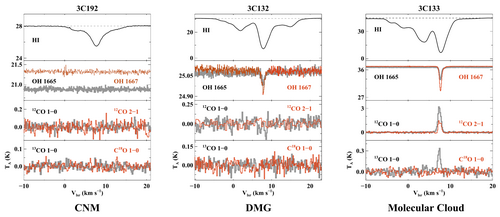Scientists from National Astronomical Observatories of Chinese Academy Sciences (NAOC), Dr. Di Li and Dr. Ningyu Tang who are leading the Pacific Rim Interstellar Observers (PRIMO) team, obtained accurate absorption measurements toward 43 quasars, based on observations from multiple telescopes including the Purple Mountain Observatory 13.7 m millimeter and the Arecibo “Millennium Survey”. It is the first systematic, combined CO emission and OH quasar absorption study of the Galactic diffuse gas. The OH excitation temperatures are found to follow a log-normal function, peaking close to the Galactic emission background, namely the Cosmic Microwave Background (CMB) and interstellar synchrotron radiation. The study also reveals persistent ‘dark’ molecular gas, which shed lights onto the star formation rate and galaxy evolution.
Hydrogen is the most abundant element in the Universe. Hydrogen gas is the most massive component of baryons in the Universe. The inventory of hydrogen gases, both atomic and molecular, in the Milky Way is thus a fundamental task, which canonically relies upon HI and CO emission. A slew of surveys (e.g. EGRET, Planck, IRAS) suggest the existence of rich molecular gas missed by HI and CO, which is dubbed ‘dark gas'. OH is the first molecule discovered in radio bands and has been believed to be abundant. The lack of large-scale OH maps is thus a mystery. This study provides a plausible explanation in setting the OH excitation temperature close to the background. OH absorption is found to trace dark gas well, and thus a promising technique for the upcoming major telescopes, including FAST and SKA, to measure the total quantity of gas in the Milky Way. Revealing dark gas is also critical for an accurate understanding of star formation.
This is paper was published on the Astrophysical Journal Supplement.
http://dx.doi.org/10.3847/1538-4365/aaa762

Typical Spectra of cold gas in the Milky Way. Left: Atomic Gas (Cold Neutral Medium) Middle: Dark Molecular Gas. Right Molecular Cloud. The dark molecular gas (DMG) is seen in HI and OH absorption with CO emission.

Address: 20A Datun Road, Chaoyang District, Beijing, China code: 100012
Tel: 010-64888708 E-mail: naoc@nao.cas.cn

